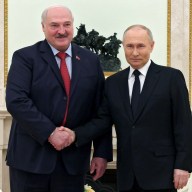LHASA, China – The Chinese paramilitary police who usually patrol Tibet’s often tense capital went to work in black and yellow track suits last week instead of their green uniforms. The occasion: a government-arranged visit by a group of foreign journalists.
Sixteen months after an uprising prompted a harsh Chinese crackdown, the four-day glimpse given to 16 foreign journalists showed official nervousness about Tibet – which has unsteadily weathered nearly six decades of Chinese rule – and how hard the government is trying to show that the uneasy region has returned to normal.
The reporters, who arrived Thursday, were taken on rushed visits to an experimental primary school in Lhasa, to a new home to meet a young Tibetan couple and their two children and to a monastery at the heart of last year’s protests.
Over the weekend, they saw trim young men in crew cuts and black and yellow track suits marching in patrols around Lhasa’s medieval Tibetan quarter.
The men said they were students and some carried math text books. But local residents said they were actually People’s Armed Police officers who had dressed in green uniforms before the reporters arrived and who have been a constant presence since anti-Chinese riots erupted in Lhasa in March 2008.
Officials said security adjustments were made for the reporters to help them report Tibet’s “true situation.”
“For the convenience of the visiting reporters, we made some special arrangements in terms of the route and the program, and we relocated some armed police officers who were patrolling,” Gongbao Zhaxi, a senior Communist Party official in the Tibetan Autonomous Region, told the reporters.
Last year’s violence, which started in Lhasa and then spread across western China, shook Chinese leaders, coming just months before the Beijing Olympics and after years in which the government invested billions of dollars into the poor region to spur development.
In response, Beijing poured troops into Tibetan areas, kept foreign media and tourists out, purged Buddhist monasteries – which have been at the centre of anti-government sentiment – and intensified a vilification campaign against the Dalai Lama, the exiled Tibetan spiritual leader, accusing him of instigating the unrest.
Arrests and detentions across Tibetan areas were widespread. Though 80 have been sentenced in quick trials, hundreds remain jailed awaiting trial. The government has never given a complete accounting and details of punishments continue to trickle out.
The harsh security and invective have served to further alienate many Tibetans and aggravate tensions, according to some Tibetans and Tibet support groups.
“The Chinese government does not want to address these problems, and they reduce it to the Dalai Lama and separatist groups. This is a way of avoiding their responsibilities,” said Woeser, a Tibetan writer and blogger based in Beijing who like many Tibetans uses one name.
Getting information out of Tibet is difficult and interviews on government-organized reporting trips are often unreliable, making it “hard to get a grasp of what’s really going on,” she said. “According to what I know, the situation is still serious.”
A monk in his 30s arranged a secret meeting with one of the foreign reporters in Lhasa on last week’s trip and described the political study classes he’s required to attend once a week at his monastery as painful.
In his interview, the monk, who had dressed in civilian clothes to avoid drawing attention to himself, told the reporter from RTE Irish radio and television that monks are forced to criticize the Dalai Lama during the classes.
More than half the monks in his monastery had returned to their home provinces or left the monkhood since last year because “they found the pressure too much,” said the monk, who asked that his name not be used to avoid punishment.
When the reporters were taken to the Jokhang Temple, the usually crowded shrine seemed empty. Two weeks after last year’s riots, about 30 monks broke down in tears in front of another group of foreign journalists, shouting for the Dalai Lama’s return and complaining about the heavy security.
The temple’s chief monk Aweng Quzha told reporters that the monks who had spoken out last year were misled by rumours and had since been given instruction in Chinese law to help them understand that what they had done was wrong.
Only about 20 monks could be seen at the temple and only one, the chief monk, spoke with reporters. Two buses carrying about 50 monks each were seen arriving at the Jokhang the next day.
–
Associated Press writer Alexa Olesen in Beijing contributed to this report.
















